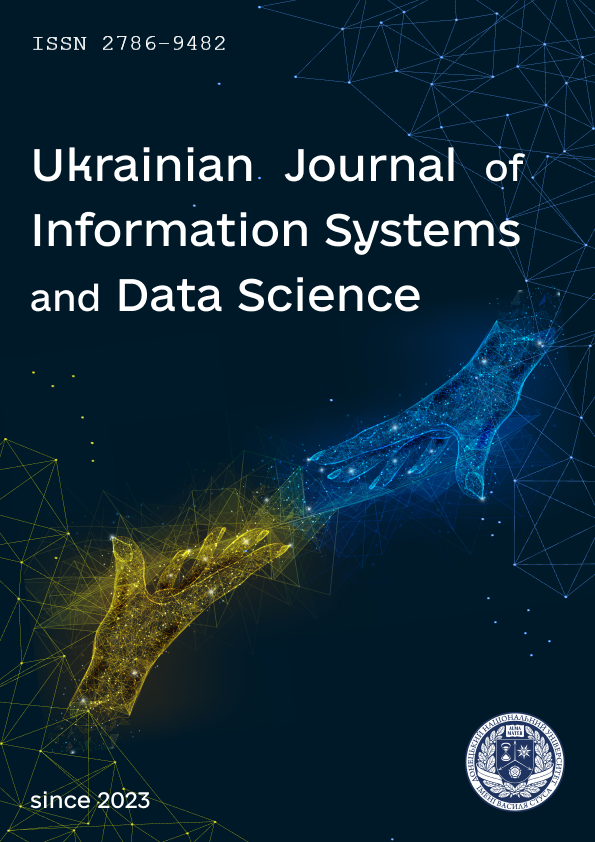Improving the accuracy of the Mamdani fuzzy rule base with double-consequent rules
DOI:
https://doi.org/10.31558/2786-9482.2023.1.5Keywords:
fuzzy inference, Mamdani-type fuzzy rules, double-consequent rule, rule selection, greedy algorithm, accuracy.Abstract
The paper considers the problem of modeling the multi-factor dependencies with a continuous output using fuzzy rule bases. One of the main competitive advantages of fuzzy modelling is the interpretability of the fuzzy rule base – it is quite easy for a user who is far from mathematical methods to understand what makes up a particular conclusion. For fuzzy modelling of dependency with continuous output, both Mamdani and Sugeno rule bases are most commonly used. The Sugeno rule base is more accurate but has low interpretability. Mamdani rule bases have high interpretability but low accuracy. It is problematic to increase the interpretability of Sugeno rule bases because this property is due to the rule format. The task of improving the accuracy of the Mamdani rule base is quite easy to formalize, so we can try to solve it in some algorithmic way. The goal of this article is to improve the accuracy of the Mamdani rule base. The way to improve the accuracy of the Mamdani rule base is to use double-consequent rules. A double-consequent rule is equivalent to two ordinal rules with the same antecedents and different consequents. The computational experiments carried out have shown that the use of double consequent rules by increasing the resolution of the linguistic description of the dependency provides better accuracy. The experiments were performed on three synthetic datasets and one real Auto MPG dataset. The selection of rules is done by a greedy algorithm. The use of double-consequent rules allows for to achievement of better accuracy and compactness of the model during the structural stage of fuzzy identification. It was also found that fuzzy inference on double-consequent rules can be implemented correctly and efficiently using the A-FATI scheme, while in previous studies a simplified B-FITA scheme was used.
References
Varshney, A. K., & Torra, V. (2023). Literature review of the recent trends and applications in various fuzzy rule-based systems. International Journal of Fuzzy Systems, 25(6), 2163–2186. DOI: 10.1007/s40815-023-01534-w.
Tavana, M., & Hajipour, V. (2020). A practical review and taxonomy of fuzzy expert systems: methods and applications. Benchmarking. Emerald Group Holdings Ltd. DOI: 10.1108/BIJ-04-2019-0178.
Cordón, O. (2011). A historical review of evolutionary learning methods for Mamdani-type fuzzy rule-based systems: Designing interpretable genetic fuzzy systems. International Journal of Approximate Reasoning. DOI: 10.1016/j.ijar.2011.03.004.
Ishibuchi, H., Nakashima, T., Murata, T. (2001). Three-objective genetics-based machine learning for linguistic rule extraction. Information Sciences, 136(1–4), 109–133. DOI: 10.1016/S0020-0255(01)00144-X.
Guillaume, S., Charnomordic, B. (2010). Interpretable fuzzy inference systems for cooperation of expert knowledge and data in agricultural applications using FisPro. 2010 IEEE World Congress on Computational Intelligence, WCCI 2010. DOI: 10.1109/FUZZY.2010.5584673.
Ojha, V., Abraham, A., Snášel, V. (2019). Heuristic design of fuzzy inference systems: A review of three decades of research. Engineering Applications of Artificial Intelligence, 85, 845–864. DOI: 10.1016/j.engappai.2019.08.010.
Shtovba, S., Shtovba, O., Pankevich, O. (2012). Accuracy and compactness criteria for evaluating the quality of fuzzy knowledge bases in identification problems. Scientific Works of Vinnytsia National Technical University, 4, URL: https://works.vntu.edu.ua/index.php/works/article/view/356
Shtovba, S., Mazurenko, V., Petrychko, M. (2020). Information technology for extracting the accurate, compact and interpretable Mamdani-type rule base. CEUR Workshop Proceedings, 2711 “Proceeding of the XI Conference on Information Control Systems & Technologies”, 386–400.
Gacto, M. J., Alcalá, R., & Herrera, F. (2011). Interpretability of linguistic fuzzy rule-based systems: An overview of interpretability measures. Information Sciences, 181(20), 4340–4360. DOI: 10.1016/j.ins.2011.02.021.
Shtovba, S. D. (2007). Ensuring accuracy and transparency of Mamdani fuzzy model in learning by experimental data. Journal of Automation and Information Sciences, 39(8), 39–52. DOI: 10.1615/JAutomatInfScien.v39.i8.50.
Nozaki, K., Ishibuchi, H., & Tanaka, H. (1997). A simple but powerful heuristic method for generating fuzzy rules from numerical data. Fuzzy Sets and Systems, 86(3), 251–270. DOI: 10.1016/0165-0114(95)00413-0.
Cordón, O., & Herrera, F. (2000). A proposal for improving the accuracy of linguistic modeling. IEEE Transactions on Fuzzy Systems, 8(3), 335–344. DOI: 10.1109/91.855921.
Alcalá, R., Casillas, J., Cordón, O., & Herrera, F. (2003). Linguistic modeling with weighted double-consequent fuzzy rules based on cooperative coevolutionary learning. Integrated Computer-Aided Engineering, 10(4), 343–355. DOI: 10.3233/ica-2003-10405.
Dutu, L. C., Mauris, G., & Bolon, P. (2018). A fast and accurate rule-base generation method for Mamdani fuzzy systems. IEEE Transactions on Fuzzy Systems, 26(2), 715–733. DOI: 10.1109/TFUZZ.2017.2688349.
Wang, L. X., & Mendel, J. M. (1992). Generating fuzzy rules by learning from examples. IEEE Transactions on Systems, Man and Cybernetics, 22(6), 1414–1427. DOI: 10.1109/21.199466.
Ruspini, E. H. (1969). A new approach to clustering. Information and Control, 15(1), 22–32. DOI: 10.1016/S0019-9958(69)90591-9.
Штовба, С. Д., Мазуренко, В. В. (2014). Інтелектуальні технології ідентифікації залежностей. Лабораторний практикум: електронний навчальний посібник. Вінниця, Вінницький національний технічний університет, 113 с.
Rotshtein, A., Rakytyanska, H. (2012). Fuzzy evidence in identification, forecasting and diagnosis. Studies in Fuzziness and Soft Computing. Vol. 275. Springer, Heidelberg, 313 р.

